|
|
 NATURE
HAPPENINGS - November 2005 NATURE
HAPPENINGS - November 2005
The Wild Trumpets
by Damian Fagan
|
I
hear the wild trumpets long before I see them. Theirs
is a distinctive rattling call punctuated by deep croaks.
The sound lures me back to a time when these birds
flew low over the heads of Ice Age mammals or prehistoric
Ancestral Puebloans who once roamed these lands.
As they come into sight the communication gets louder, more frequent. “Who’s
gotta stop?” seems to be the general communication that ripples
through the flock. The wide V-shaped pattern might indicate geese,
but the calls, the long straight necks and legs trailing in flight
reveal their true identity: Sandhill cranes.
Their passage through the Moab Valley is not a common occurrence.
Though they may stop and forage in the Matheson Preserve or an abandoned
agricultural field, it seems that their visits are quick ones. The
birds are gone long before the “bird on a wire” network
goes into effect. Perhaps they are on their way to the bosques along
the Rio Grande River in New Mexico, where thousands of their kind
gather to spend the winter.
I’ve seen rock art panels chipped into stone walls by some
ancient birder who, like me, probably stood and stared as the birds
passed overhead. The images on stone have long necks but they could
easily represent a heron as much as a crane. Though these two birds
share an overall long-legged stature, the two are as different as
loons are from ducks.
Their similarity resides in their diets, for these are “seefood” eaters:
They see food and they eat it. Their diet consists of aquatic invertebrates,
crabs, clams, toads, frogs, snakes, and fish. The cranes partake
of nuts, berries, leaves, roots, and agricultural or wild grains,
whereas the herons are a bit more catholic in their diets. Both may
forage in mudflats or shallow waters, but generally only the cranes
are found in agricultural fields.
Though both engage in stylized courtship, it is the crane’s
version that captures more attention. During courtship, as the birds
pair up, they dip and bow to one another, then leap like ballet dancers
in the air. Aloft they hold their wings half spread, then bow like
Parisian courtiers when they land. Their wing feathers overlap and
trail off the bird’s rump like a bustle or knotted sash furthering
this “elegant” nature of these mate-for-life birds. Their
dawn and dusk duets echo across the open landscape, often inciting
a responding chorus from the other nearby pairs.
After the breeding season in which the pair might raise one or two
young, the birds depart for their southern wintering homes. In migration,
these cranes may travel for nine to ten hours at a time, riding thermals
in V-shaped formations of a dozen or more members. With a favorable
wind they may travel 500 miles in a day, then rest for several days
before continuing their southbound journey.
Robert Ridgeway (1850-1929) the seventeen year-old zoologist on the
United States Geological Exploration of the Fortieth Parallel wrote
about these cranes in the Great Basin in the late 1860s. “Sand-hill
Crane was an abundant species in nearly all localities where extensive
grassy marshes or wet meadows existed.” The young Ridgeway
observed and collected bird specimens during that expedition, before
returning to Washington, D.C. to eventually become a leading ornithologist
of his time. Yet, his notes on the birds’ abundance would indicate
they have not faired well with the progress of time.
These cranes are absent from many of their former breeding grounds
in the Great Basin and elsewhere. The conversion of marshes and meadows
into agricultural fields or urban settings has forced them out of
some of their old haunts. Although populations seem stable, certain
subspecies have been included on the list of endangered species.
Though I can not predict the future of these magnificent birds, I
can appreciate their beauty in their passage high overhead. As the
leaves of autumn cascade to earth, I wish these long-legged flyer
well and good speed, hoping to catch a glimpse of them during their
springtime, northbound flight.
|
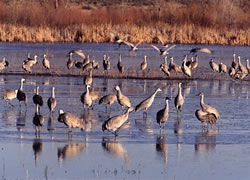
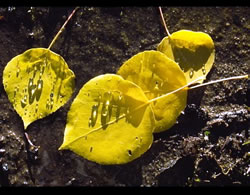
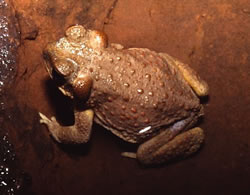
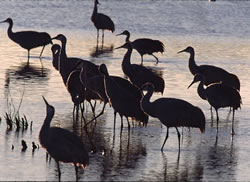
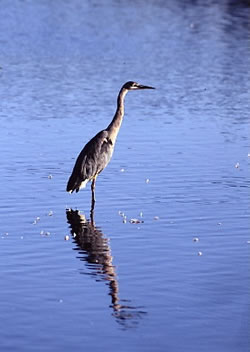
|
|
|
|
|
|
|
|
|
© 2002-2024 Moab Happenings. All rights
reserved.
Reproduction of information contained in this site is
expressly prohibited.
|
|